We’re going to use a game structure called streetcrawling. You rarely want to track movement in an urban environment street by street (see The Art of Pacing), but there are occasions where the city is perilous, confusing, difficult, and/or treacherous enough that the PCs have to crawl through the streets (in much the same way that they might crawl through a dungeon or explore a hexcrawl). Lost in a post-apocalyptic city trapped in Hell definitely counts.
STEP 1 – SET GOAL: Establish the goal the PCs are trying to reach. This goal can be either specific (e.g., Helm’s Shieldhall) or generic (e.g., ‘someone who knows what’s going on’ or ‘a source of clean water’).
STEP 2 – GENERATE STREETS: Use the Street Generator (below) to determine the local street layout and the relationship between where the PCs are and where their goal is located.
STEP 3 – ORIENT: The PCs need to figure out how to go to where their goal is located. Options include:
- Their goal can be spotted from a distance. (For example, if they look around for a high tower to climb, they’ll probably be able to spot one.)
- They can ask the locals for directions.
- They can attempt an appropriate skill check to make an educated guess.
- They could use magic (like a locate object spell).
- They know the city (or have a map) and they know where their goal is.
If they can’t figure out how to go to their goal, then their first goal is actually going some place where they CAN figure that out. Or they’re randomly wandering (see below) and just hoping to stumble across something that will point them in the right direction.
STEP 4 – RANDOM ENCOUNTER: Check for a random encounter (see below).
STEP 5 – ARRIVAL: The PCs arrive at their goal.
If their goal was figuring out a way to get their bearings, then this will likely conclude the streetcrawling and transition to pointcrawling (see Part 5C: Pointcrawl in Elturel).
Design Note: What if the players don’t make orienting themselves a priority? What if they want to achieve some other goal? That’s fine. Use the streetcrawl structure to resolve whatever goal or goals they set for themselves.
In the process of pursuing other goals, they may unintentionally get their bearings. (For example, one of them might fly up into the air for some completely unrelated reason and see the city spread out below them.) That’s great. An equally likely outcome is that they’ll get frustrated trying to navigate the city when they really don’t know where they’re going and eventually figure out that they need to do something to get their bearings.
STREET GENERATOR
If you have a highly detailed map of your city, you can just grab a chunk of the streets depicted on the map and use those for your crawl. If you don’t have a map of the city or if that map is not particularly detailed, however, you can use this simple system to generate local street maps. (For a lengthier discussion of this, check out Random GM Tip: Visualizing City Block Maps.)
In the case of Elturel, the maps we have for the city arguably straddle the line between these two types of depiction. For example, look at this chunk of map:
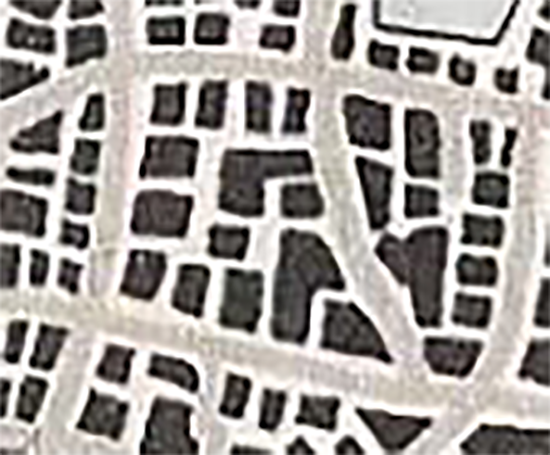
You might look at that and clearly see streets, like this:
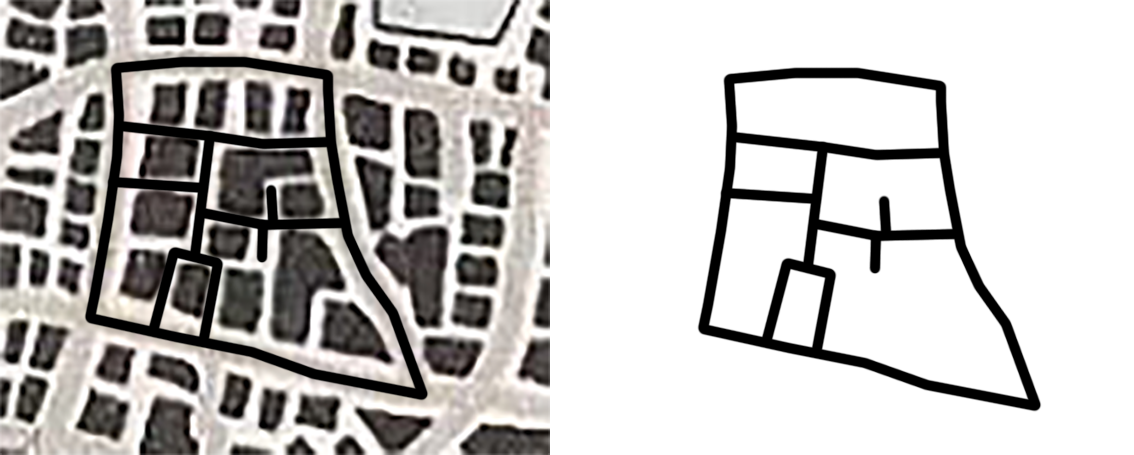
If you do, great. You can just sketch those local streets out on a sheet of paper and use that for your crawl.
For the sake of argument, however, I’m going to instead focus on the shape of the major streets which define the borders of this particular locality and sketch that onto a sheet of paper:
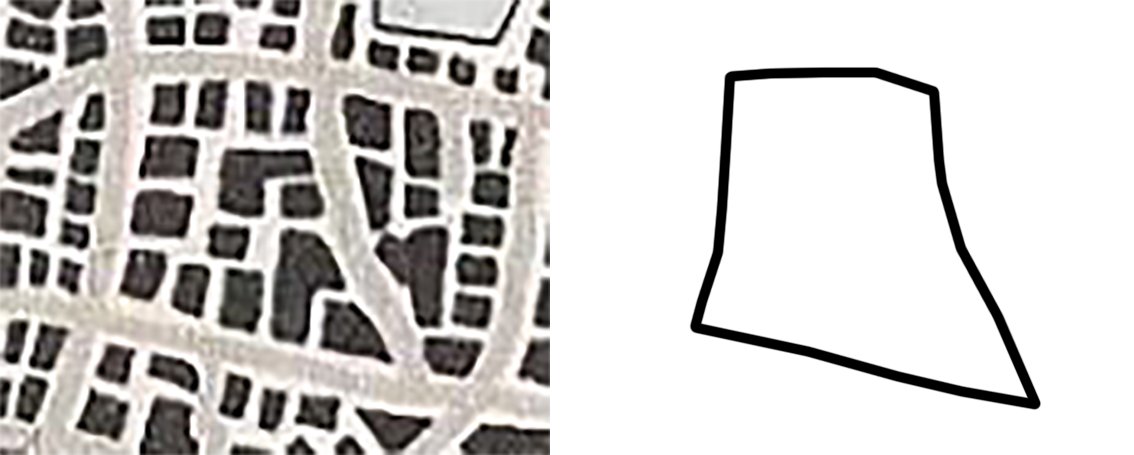
If you don’t have a city map at all to base these outlines on, you can either arbitrarily sketch the major streets bordering the area or just treat the edges of the current sheet of paper as the locality’s edge.
ROLLING THE DICE: This is a tablemat system, so you are now going to take a handful of street dice and location dice and roll them directly onto the sheet of paper. The locations where these dice land on the paper are as important (or more important) than the numbers they roll. If a die rolls off the paper, you can either re-roll it or ignore it.
Tip: You generally want to have the dice spread out across the available space, not clustered together.
STREET DICE: Take an arbitrary number of d4’s to be street dice. The larger the number of street dice, the larger the number of streets and the more convoluted the street plan you’ll generate. I’ve generally found that rolling 4d4 produces a good result.
The location where each die lands is an intersection and the number of streets attached to that intersection is equal to the number rolled on the dice.
LOCATION DICE: Location dice are d10’s. You roll a number of location dice equal to the number of locations where the PCs’ goal can be achieved in the current locality. If this is the beginning of the streetcrawl, add an additional location die (and the lowest die rolled will be the PCs’ starting location).
Tip: Streets can curve. Adding a curve when one is necessary for a street to intersect with a location die is a good prompt for adding a little variety to your street map.
For example, using the block outline from above to start our streetcrawl, we’re going to roll four street dice and two location dice (one for a goal location and one for the PCs’ starting location):
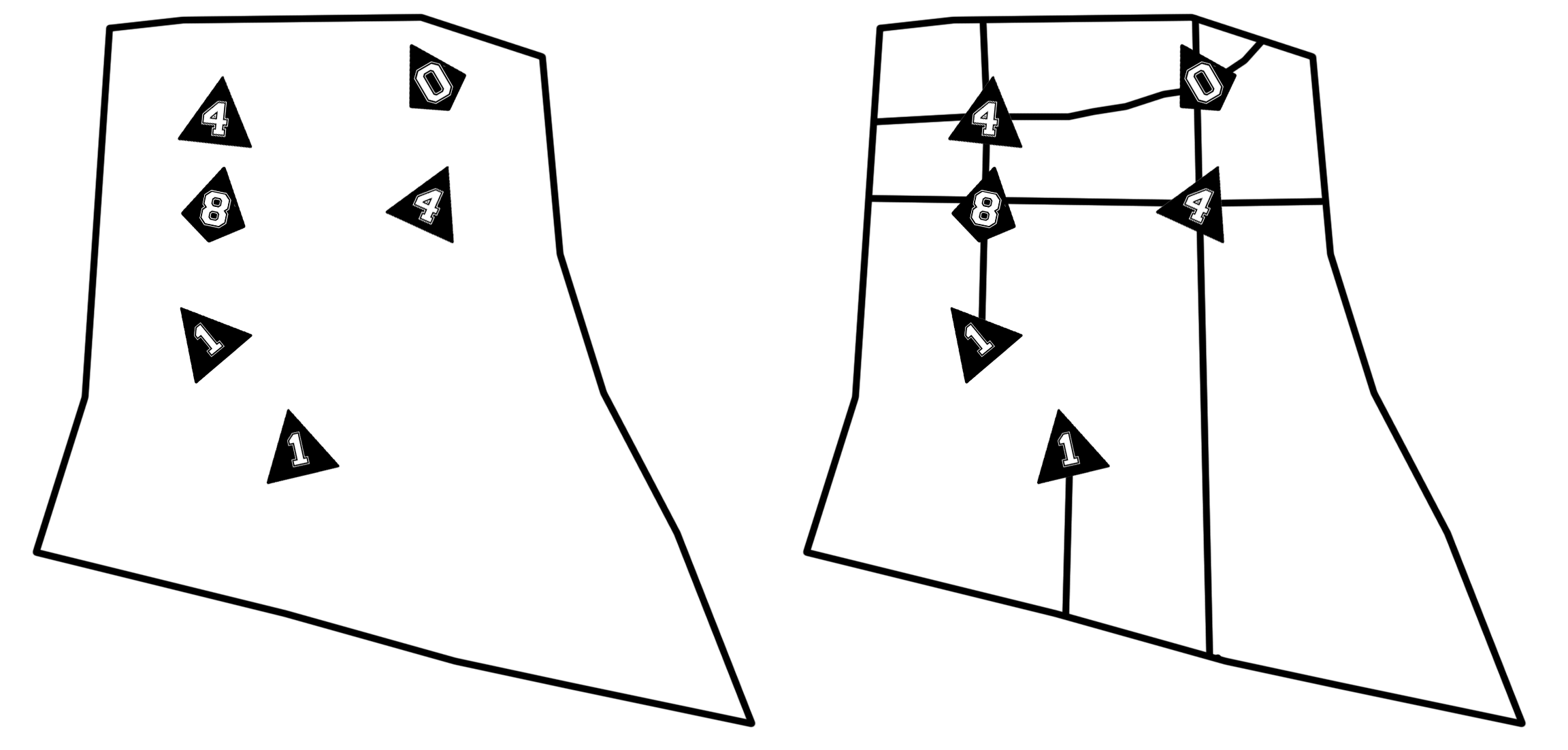
That’s not the only set of streets that could have been generated from that particular die roll. There is no “right answer.” The point is to be able to very quickly generate local street maps during the session by tossing some dice on the table and sketching out a few lines.
Here’s what the final locality map looks like with the dice swept aside (and surrounding streets added for context):
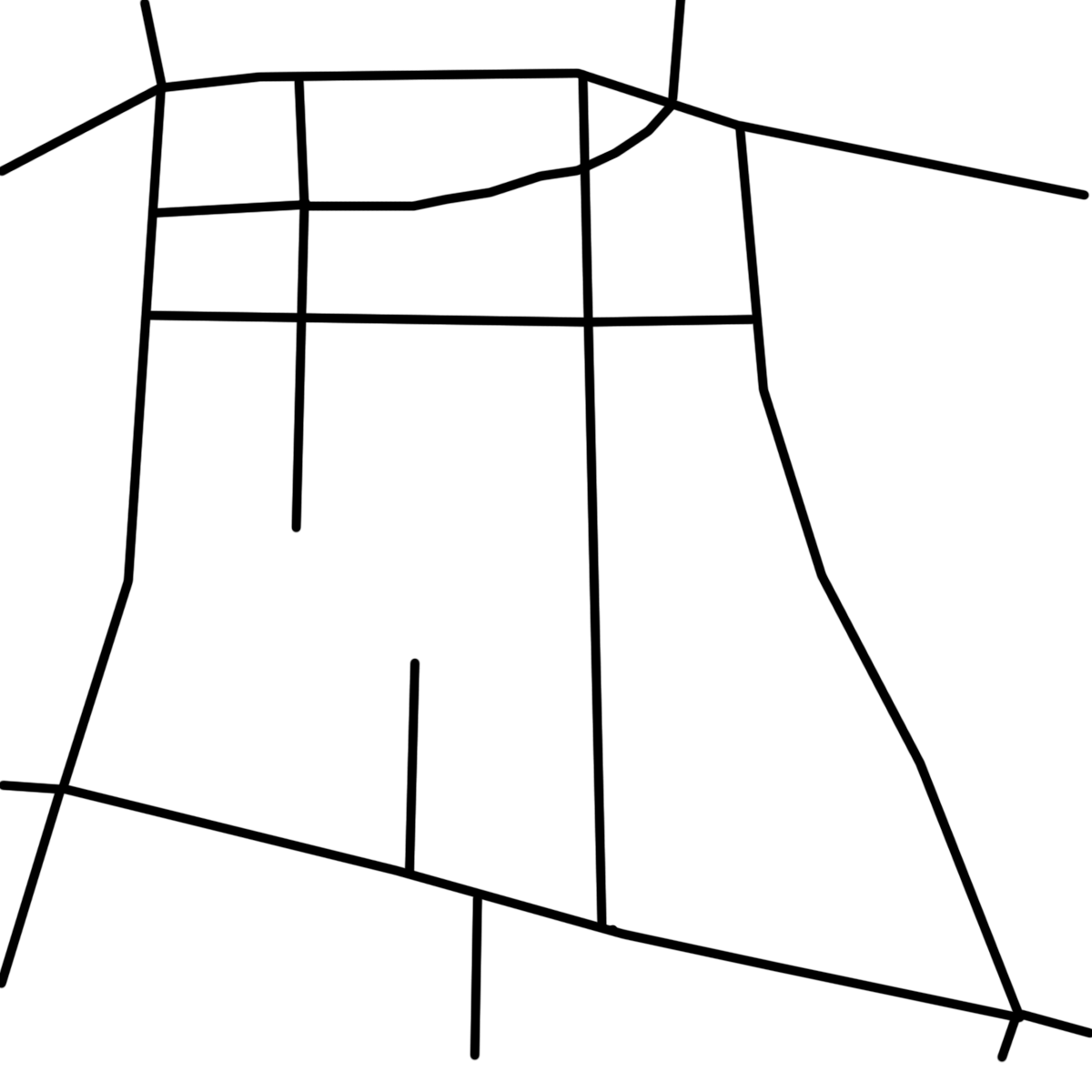
RANDOM ENCOUNTERS
If you’re familiar with using random encounters in dungeons, you’ll want to make a mental adjustment for streetcrawls for several reasons:
- Cities are usually filled with a lot more activity and encounters should be more common.
- Navigational choices in the city are usually trivial or random, which makes them less inherently interesting.
- There are no rooms keyed with interesting content in a streetcrawl; the encounters need to carry more of the weight.
For example, in an old school dungeon a random encounter often happens 1 in 6 times per check. In a streetcrawl, you might want to have encounters 1 in 4, 1 in 2, or even 2 in 3 times.
Tip: For a short, simple streetcrawl like the one we’re most likely using for the PCs’ arrival in Elturel, I’d recommend just automatically slotting in an encounter. You might actually want to take the initial “woman running from devils” encounter (DEVILS!) and use it as the encounter for their initial streetcrawling move.
ELTUREL RANDOM ENCOUNTERS: I’m going to discuss the random encounters we’ll be using for Elturel in more detail in Part 5C.
DISTANT GOALS
If the goal the PCs are trying to reach is not local, then the immediate goal is actually ‘move one chunk of city closer to the goal.’ When generating streets, only roll one location die to determine the PCs’ starting location. Their immediate goal can obviously be achieved by reaching the appropriate edge of the current crawl map. (You’ll want to determine the number of chunks necessary to reach the locality of their goal.)
Note: When dealing with distant goals it will often be more appropriate to exit the streetcrawling structure while the PCs travel to the general vicinity of their goal and then resume crawling. (Imagine the PCs in a city they’re familiar with. If they’re in Oldtown and know that Old Tom is hiding somewhere down by the Docks, they don’t need to crawl their way across the whole city: They can just go to the Docks and then start crawling to find Old Tom.) In the case of Elturel, the point where this would become appropriate is likely also the point where we’ll be switching to a pointcrawl structure (see Part 5C). But it is possible for the PCs to strike out before getting their bearings (for example, they might head straight towards the High Hall after spotting it towering above the city).
CRAWLING WITHOUT A GOAL
If the PCs don’t have a goal:
STEP 1: Use the street generator to determine the local street layout, rolling a location die only to determine the PCs’ starting location.
STEP 2: The PCs choose a direction to walk. (Presumably at random.)
STEP 3: Check for a random encounter on each street they walk down.
If they reach the edge of the local map, use the street generator again to extend the map and continue crawling.
Generally speaking, this style of play should not persist for long. Context should prompt the PCs to begin setting goals. (Even if they’re just “wandering around looking for something to do,” the random encounters or street descriptions should eventually give them something to do or become interested in pursuing.)
RANDOM WANDERING
If the PCs are hoping to find something but have no idea where it might be or how they might get there, they are randomly wandering. Follow the same procedure as crawling without a goal, but roll location dice normally to determine the location(s) of what they’re looking for.
At any time, of course, they may be able to figure out how to orient themselves (running into an NPC they can ask for directions, etc.), at which point they’ll no longer be randomly wandering.
Note: Wandering randomly is generally a terrible way of finding a specific location. (Since you can easily go in completely the wrong direction and never find it.) It works better if they’re looking for a generic type of thing, since even if they miss one such thing they can stumble across another. (For example, there are any number of hardware stores you could hit up for supplies during a zombie apocalypse.)
WANDERING THE CITY: Some goals can be found almost anywhere you look in a city (e.g., someone to talk to). Other goals might be rare or found in only certain locations of the city. As the GM you can arbitrarily decide this based on your understanding and knowledge of the city (there’s one local alchemist nearby; the alchemists are over in the Dewberry neighborhood and they’ll have to crawl there; etc.). Alternatively, you can make a ruling for how likely they are to find the thing they’re looking for in a particular chunk of city and then roll to randomly determine if there’s one local to them. Examples include:
- 1 in 100 chance (for perhaps a specific location that they know is somewhere in the city, but have no idea where or if they’re even close to it).
- 1 in 6 chance (for something that is known to be “around here somewhere”; or that’s relatively rare in the city)
- 1 in 4 chance (for something that’s fairly common in the city, like a public fountain)
- 1d4-1 per locality (for something that can be found almost anywhere in the city, like bodegas in Manhattan)
And so forth.
CONCLUSION
I’ve dropped an entirely new scenario structure on you. That may be a lot to process, so let’s take a step back and do a quick recap on how this is likely to work out in play:
- The PCs show up in Elturel.
- They look around for a high place to get their bearings from.
- You generate a local street map.
- As they walk from their current location to the location of the tower they’ve spotted, you trigger the “woman running from devils” encounter (contextualizing the encounter based on the street map you’ve generated).
- After that (likely a fight) scene, they continue on their way, reach the tower, climb the tower, look around (WE ARE FLOATING IN THE GODDAMN AIR!), receive the poster map, and transition to pointcrawling (see Part 5C).
That’s it.
So what’s the deal with the whole streetcrawling structure? Isn’t it overkill? Couldn’t we just prep a locality street map of the area where the PCs appear with the location of the tower indicated? Possibly. But the reason we want the structure is because this might NOT be the way it goes in play: Players are fickle and unpredictable generators of random chaos. As we’ve already discussed, they might go in any number of unexpected directions.
This structure can easily generate the likely outcome described above, but it can just as easily handle anything that the players choose to throw your way.
Without this kind of structure (either formal or informal), your only option would be to have a GMPC tell the PCs what to do. (And then get frustrated when they don’t.)
Go to Addendum: Streetcrawling Tools – Part 5C-A: Pointcrawl in Elturel

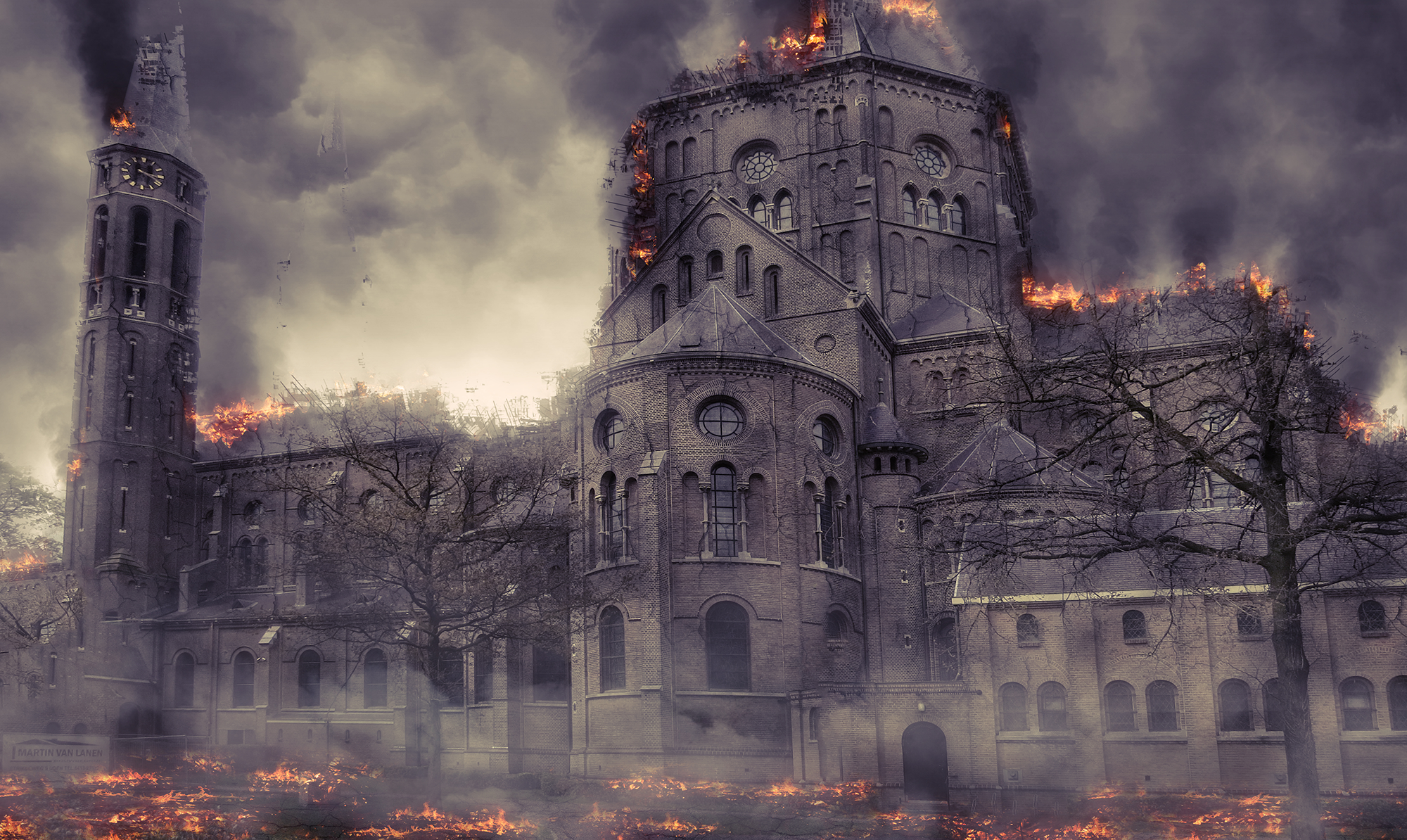











I think this should be tagged to your series about urbancrawl/Wilderness crawl series. Smaller in scope but some very solid advice in there
A couple of my PCs are from Elturel (one is a Hellrider the other a merchant from Lantan who set up shop there in the recent past) and it could be assumed they have good knowledge of the city streets and locations.
Do you think this changes the streetcrawl aspects? You mention under Orienting themselves, “They know the city (or have a map) and they know where their goal is.” so does this bypass the streetcrawl?
My only problem with that is the loss of the discovery that Elturel is chained up in the air.
The easiest way they have to orient themselves is sending Lulu into the air.